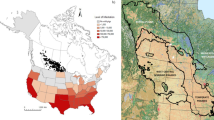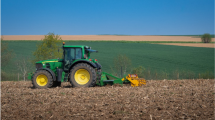Abstract
Increased production of bioenergy crops in North America is projected to exacerbate already heavy demands upon existing agricultural landscapes with potential to impact biodiversity negatively. Grassland specialist birds are an imperilled avifauna for which perennial-based, next-generation agroenergy feedstocks may provide suitable habitat. We take a multi-scaled spatial approach to evaluate the ability of two candidate second-generation agroenergy feedstocks (switchgrass, Panicum virgatum, and mixed grass–forb plantings) to act as spring migratory stopover habitat for birds. In total, we detected 35 bird species in mixed grass–forb plantings and switchgrass plantings, including grassland specialists and species of state and national conservation concern (e.g., Henslow’s Sparrow, Ammodramus henslowii). Some evidence indicated that patches with higher arthropod food availability attracted a greater diversity of migrant bird species, but species richness, total bird abundance, and the abundance of grassland specialist species were similar in fields planted with either feedstock. Species richness per unit area (species density) was relatively higher in switchgrass fields. The percent land cover of forest in landscapes surrounding study fields was negatively associated with bird species richness and species density. Habitat patch size and within-patch vegetation structure were unimportant in predicting the diversity or abundance of spring en route bird assemblages. Our results demonstrate that both switchgrass and mixed grass–forb plantings can attract diverse assemblages of migrant birds. As such, industrialized production of these feedstocks as agroenergy crops has the potential to provide a source of en route habitat for birds, particularly where fields are located in relatively unforested landscapes. Because industrialization of cellulosic biomass production will favor as yet unknown harvest and management regimes, predicting the ultimate value of perennial-based biomass plantings for spring migrants remains difficult.


Similar content being viewed by others
References
European Union (2009) Directive 2009/28/EC of the European Parliament and of the Council of 23 April, 2009 on the promotion of the use of energy from renewable sources and amending and subsequently repealing directives 2001/77/EC and 2003/30/EC
US Congress (2007) Energy Independence and Security Act of 2007. Renewable fuels directive. http://www.govtrack.us/congress/billtext.xpd?bill=h110-6. Accessed 26 May 2009
West T, Dunphy-Guzman K, Sun A, Malczynski L, Reichmuth D, Larson R et al (2009) Feasibility, economics, and environmental impact of producing 90 billion gallons of ethanol per year by 2030. Sandia National Laboratories, Livermore
Green RE, Cornell SJ, Scharlemann JPW, Balmford A (2005) Farming and the fate of wild nature. Science 307:550–555
Millennium Ecosystem Assessment (2005) Ecosystems and human well-being: biodiversity synthesis. World Resources Institute, Washington, DC
Fargione JE, Cooper TR, Flaspohler DJ, Hill J, Lehman C, McCoy T et al (2009) Bioenergy and wildlife: threats and opportunities for grassland conservation. Bioscience 59:767–777
Meehan TD, Hurlbert AH, Gratton C (2010) Bird communities in future bioenergy landscapes of the Upper Midwest. PNAS 107:18533–18538
Fletcher RJ, Robertson BA, Evans J, Doran P, Alavalapati JRR, Schemske D (2011) Biodiversity conservation in the era of biofuels: risks and opportunities. Front Ecol Env 9:161–168
Tilman D, Hill J, Lehman C (2006) Carbon-negative biofuels from low-input high-diversity grassland biomass. Science 314:1598–1600
Sauer JR, Hines JE, Fallon J (2008) The North American breeding bird survey, results and analysis 1966–2007. Version 5.15.2008. USGS Patuxent Wildlife Research Center, Laurel
Scharlemann JPW (2008) Can bird research clarify the biodiversity benefits and drawbacks of biofuels? Ibis 150:640–642
Robertson BA, Doran P, Robertson R, Loomis L, Schemske D (2011) Perennial biomass feedstocks enhance avian diversity. GCB Bioenergy 3:235–246
Askins RA, Chavez-Ramirez F, Dale BC, Haas CA, Herkert JA (2007) Conservation of grassland birds in North America: understanding ecological processes in different regions. Ornithol Monogr 124:1–46
Sillett TS, Holmes RT (2002) Variation in survivorship of a migratory songbird throughout its annual cycle. J Anim Ecol 71:296–308
Robertson BA, Robertson JR, Loomis ER, Doran JP, Schemske DW (2011) Avian use of perennial biomass feedstocks as post-breeding and migratory stopover habitat. PLoS One 6(3):E16941
Sample DW, Mossman MJ (1997) Management of habitat for grassland birds: a guide for Wisconsin. Wisconsin Department of Natural Resources, Madison
Moore FR, Gauthreaux SAJ, Kerlinger P, Simons TR (1995) Habitat requirements during migration: important link in conservation. In: Martin TE, Finch DM (eds) Ecology and management of neotropical migratory birds. Oxford University Press, Oxford, pp 121–144
Rodewald PG, Brittingham MC (2004) Stopover habitats of landbirds during fall: use of edge-dominated and early-successional forests. Auk 121:1040–1055
Martin TE (1980) Diversity and abundance of spring migratory birds using habitat islands on the Great Plains. Condor 82:430–439
Buler JJ, Moore FR, Norris K (2007) A multi-scale examination of stopover habitat use by birds. Ecology 88:1789–1802
Emlen JT (1977) Estimating breeding season bird densities from transect counts. Auk 94:455–468
Fletcher RJ, Dhundale JA, Dean TF (2000) Estimating non-breeding season bird abundance in prairies: a comparison of two survey techniques. J Field Ornith 71:321–329
Ribic CA, Koford R, Herkert JR, Johnson DH, Niemuth ND, Naugle DE et al (2009) Area sensitivity in North American grassland birds: patterns and processes. Auk 126:233–244
Herkert JR (1994) The effects of habitat fragmentation on Midwestern grassland bird communities. Ecol Appl 4:461–471
Harmoney KR, Moore KJ, George R, Brummer EC, Russell JR (1997) Determination of pasture biomass using four indirect methods. Agron J 89:665–672
Robel RJ, Briggsa JN, Datytonan D, Hulbert DLC (1970) Relationships between visual obstruction measurements and weight of grassland vegetation. J Range Manage 23:295–297
Daubenmire R (1959) A canopy-coverage method of vegetation analysis. Northwest Sci 33:43–64
Weins JA (1974) Habitat heterogeneity and avian community structure in North American grasslands. Am Midl Nat 91:195–213
ESRI (2008) ArcGIS. ESRI, Redlands
United States Department of Agriculture (2010) 2009 Cropland data layer. National Agricultural Statistics Service, Washington, D.C
Rogers LE, Hinds WT, Buschbom RL (1976) A general weight vs. length relationship for insects. Ann Ent Soc Am 69:387–389
Hódar JA (1996) The use of regression equations for estimation of arthropod biomass in ecological studies. Acta Ecol 17:421–433
Colwell RK (1997) EstimateS: statistical estimation of species richness and shared species from samples. Version 5. User’s guide and application. Available: http://viceroy.eeb.uconn.edu/estimates. Accessed 27 July 2010
Vickery PD, Tubaro PL, Dasilva JMC, Peterjohn BG, Herkert JR, Cavalcanti RB (1999) Conservation of grassland birds in the Western Hemisphere. In: Vickery PD, Herkert JR (eds) Ecology and conservation of grassland birds of the Western Hemisphere. Stud Avian Biol 19. Cooper Ornithological Society, Camarillo, pp 2–26
Rosenzweig ML (1995) Species diversity in space and time. Cambridge University Press, Cambridge
Burnham KP, Anderson DR (2002) Model selection and multimodel inference: a practical information-theoretic approach, 2nd edn. Springer, New York
R Development Core Team (2010) R: A language and environment for statistical computing. R Foundation for Statistical Computing. Vienna. Version 2.12.1. ISBN 3-900051-12-7. http://www.R-project.org. Accessed 9 March 2012
Legendre P, Vaudor A (1991) The R Package: Multidimensional analysis, spatial analysis. Department of Biological Sciences, University of Montréal, Montréal
Bivand R, Altman M, Anselin L et al. (2010) Package ‘spdep’, R Foundation for Statistical Computing, Vienna, Austria. http://www.r-project.org/. Accessed 15 Nov 2010
Gardiner MA, Tuell JK, Isaacs R, Gibbs J, Ascher JS, Landis DA (2010) Implications of three model biofuel crops for beneficial arthropods in agricultural landscapes. Bioenergy Res 3:6–9
Deppe JL, Rotenberry JT (2008) Scale-dependent habitat use by fall migratory birds: vegetation structure, floristics, and geography. Ecol Monogr 78:461–487
Hutto RL (1985) Seasonal changes in the habitat distribution of transient insectivorous birds in south eastern Arizona: competition mediated? Auk 102:120–132
Moore FR, Kerlinger P, Simons TR (1990) Stopover on a Gulf coast barrier island by spring trans-Gulf migrants. Wilson Bull 102:487–500
Champlin TB, Kilgo JC, Moorman CE (2009) Food abundance does not determine bird use of early-successional habitat. Ecology 90:1586–1594
Blake JG (1984) A seasonal analysis of bird communities in southern Nevada. Southwest Nat 29:463–474
Dinsmore JJ, Kent TH, Koenig D, Peterson PC, Roosa DM (1984) Iowa birds. Iowa State University Press, Ames
Farley GH, Ellis LM, Stuart JN, Scorr NJ (1994) Avian species richness in different aged stands of riparian forest along the middle Rio Grande, New Mexico. Cons Biol 8:1098–1108
Petit DR (2000) Habitat use by landbirds along Neartic–Neotropical migration routes: implications for conservation of stopover habitats. Stud Avian Biol 20:15–33
Ribic CA, Sample DW (2001) Associations of grassland birds with landscape factors in southern Wisconsin. Am Midl Nat 146:105–121
Moore FR, Yong W (1991) Evidence of food based competition among passerine migrants during stopover. Behav Ecol Sociobiol 28:85–90
Cimprich DA, Woodrey MS, Moore FR (2005) Passerine migrants respond to variation in predation risk during stopover. Anim Behav 69:1173–1197
Bakker KK, Naugle DE, Higgins KF (2002) Incorporating landscape attributes into models for migratory grassland bird conservation. Cons Biol 16:1638–1646
Chartier AT, Ziarno J (2004) A birders guide to Michigan. American Birding Association, Colorado Springs
Berthold P, Terrill SB (1991) Recent advances in studies of bird migration. Ann Rev Ecol Syst 22:357–378
Adler PR, Sanderson MA, Weimer PJ, Vogel KP (2009) Plant species composition and biofuel yields of conservation grasslands. Ecol Appl 19:2202–2209
Galle AM, Linz GM, Homan JH, Bleier WJ (2009) Avian use of harvested crop fields in North Dakota during spring. West N Am Nat 69:491–500
Roth AM, Sample DW, Ribic CA, Paine L, Undersander DJ, Bartelt GA (2005) Grassland bird response to harvesting switchgrass as a biomass energy crop. Biomass Bioenergy 28:490–498
National Audubon Society (2007) Audubon watchlist. http://web1.audubon.org/science/species/watchlist. Accessed 7 Jan 2009
Acknowledgments
This work was funded by the Migratory Bird Center of the Smithsonian Conservation Biology Institute, US Fish and Wildlife Service (grant # 30181AG045), the DOE Great Lakes Bioenergy Research Center (DOE BER Office of Science DE-FC02-07ER64494), DOE OBP Office of Energy Efficiency and Renewable Energy (DE-AC05-76RL01830), and the U.S. National Science Foundation LTER program.
Author information
Authors and Affiliations
Corresponding author
Rights and permissions
About this article
Cite this article
Robertson, B.A., Landis, D.A., Sillett, T.S. et al. Perennial Agroenergy Feedstocks as En Route Habitat for Spring Migratory Birds. Bioenerg. Res. 6, 311–320 (2013). https://doi.org/10.1007/s12155-012-9258-3
Published:
Issue Date:
DOI: https://doi.org/10.1007/s12155-012-9258-3




